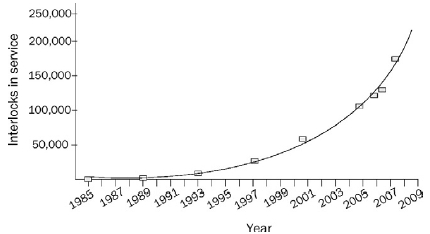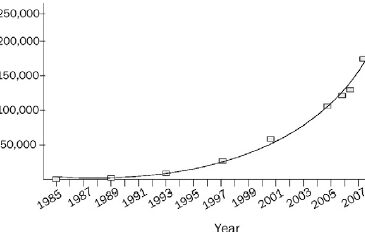This week, the DRAM continues its series focusing on driving under the influence (DUI). This is the third of five issues concentrating on the body of recent DUI research. In the first two issues, DRAM Vol. 7(5) and DRAM Vol. 7(6), we addressed DUI-related trends and methods to detect heavy alcohol consumption and recidivism.
Ignition Interlock Devices (IIDs) are gaining rapid popularity among State governments as tools to reduce DUI recidivism. The Figure shows the rapid increase in the number of IIDs installed in recent years. An IID is a dashboard-mounted device that requires an operator to provide a breath sample periodically. If the device detects more than a predetermined amount of alcohol, the car’s engine will not start. Today’s DRAM reviews a meta-analysis of 15 studies assessing the effectiveness of IIDs (Elder, Voas, Bierness, Shults, Sleet, Nichols & Compton, 2011).

Figure. The rapid increase in the number of IIDs installed (from Elder et al., 2011). Click image to enlarge.
Methods
- Researchers identified 15 studies examining various IID programs around the US.
- Although programs differed in their exact protocols, all targeted high-risk offenders, were offered in conjunction with a reduced sentence, and required IID installation for a minimum period of time.
Results
- The studies that examined the effects of IID installation on recidivism all found that IID installation was associated with lowered rates of recidivism.
- Across studies, recidivism was 60%-75% lower for offenders with IIDs than for those without.
- The only randomized control trial of IIDs found a 63% decrease in alcohol-related re-arrest among the IID group compared to a conventional treatment group (Beck, Rauch, Baker, & Williams, 1999). It is important to note that only a small percentage of either group were re-arrested.
- No studies found evidence of long-term behavioral change after IID removal. In all studies that measured recidivism after IID removal, recidivism rates among those who had IIDs installed rebounded to pre-IID levels post-removal.
Limitations
- No studies monitored participants to ensure compliance with IID guidelines. Research suggests people can circumvent IIDs by providing a third-party breath sample or illegally driving a car without an IID (Marques & Voas, 2010).
- Only one of the 15 studies was a true randomized control trial. Additional randomized controlled trials will help further clarify the effects of IIDs on recidivism.
Discussion
These results suggest that IIDs are an effective tool against future DUI reoffense among recidivist DUI offenders while installed. However, the fact that IIDs are effective only while installed suggests that IIDs do not influence driving habits and behavior in the long-term, but rather reduce offenders’ access to vehicles after drinking. As a result, IIDs should be viewed not as a silver bullet, but as one tool to be used in conjunction with other tools, as part of a comprehensive strategy against DUI.
-Daniel Tao
What do you think? Please use the comment link below to provide feedback on this article.
References
Beck, K. H., Rauch, W. J., Baker, E. A., & Williams, A. F. (1999). Effects of Ignition Interlock License Restrictions on drivers with multiple alcohol offenses: A randomized trial in Maryland. American Journal of Public Health, 89(1), 1696-1700.
Elder, R. W., Voas, R., Beirness, D., Shults, R. A., Sleet, D. A., Nichols, J. L., & Compton, R. (2011). Effectiveness of Ignition Interlocks for preventing alcohol-impaired driving and alcohol-related crashes: A community guide systematic review. American Journal of Preventive Medicine, 40(3), 362-376.
Marques, P. R., & Voas, R. B. (2010). Key features for ignition interlock programs (No. DOT HS 811 262). Washington, DC: NHTSA.




